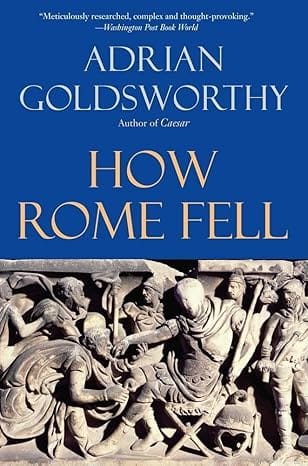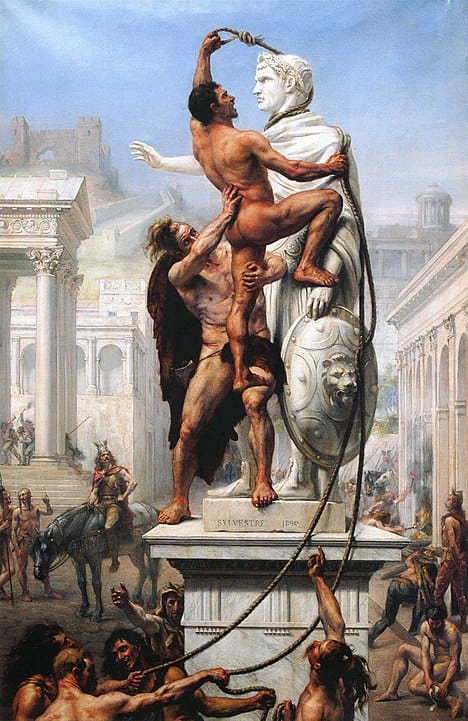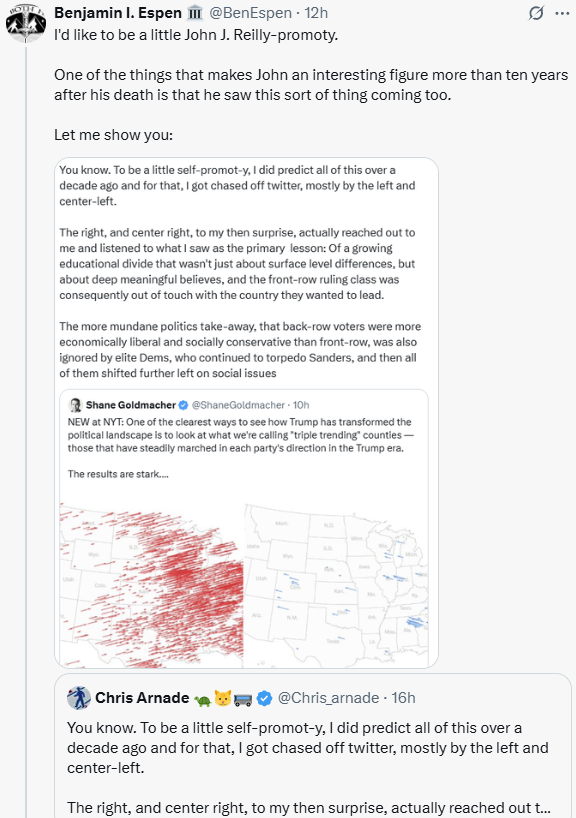The Long View: How Rome Fell

And now we have John's review/reflection on just how the Western Roman Empire became capable of falling. As John was keenly interested in cyclical theories of history, it should come as no surprise that John's analysis is a combination of decreasing state capacity occurring in a vicious cycle with cultural changes that made further decrease inevitable.
In a discussion about the way in which power shifted from the senatorial order to the equestrian order, John also alludes to some of the demographic changes underlying the political and cultural changes.
Under the Principate (the first two centuries of the empire), it was unimaginable that anyone but a member of the senatorial order could become emperor. The order included not just current members of the Senate, who were men who had held one of the ancient municipal offices of the City of Rome, but also all the members of the families that traditionally served in the Senate. The principal members of the imperial administration were likely to be senators. Increasingly, though, the emperors made use of the equestrian order, a much larger group without the sense of common identity and interests that the senatorial order had. In the disorder after the assassination of Marcus's fool of a son, Commodus (161-192), the pool of possible emperors expanded as the army saw fit. After Septimus Severus (145-211), it became conceivable that just about anyone could become emperor. For most of the following century, just about anyone did.
One of the few good things I have to say about Mary Beard's SPQR is that she captures one of the central mysteries at the heart of Rome. The story of Rome is first and foremost the story of a few prominent families who dominated the city of Rome for hundreds of years. And at the same time, Rome was also capable of instilling in both its allies and its defeated enemies a sense of Romanness that eventually formally incorporated people from Britain to Palestine as Roman citizens.
This kind of thing is what Toynbee called a universal state, which is at one and the same time a towering cultural accomplishment and a kind of cultural exhaustion that occurs when there is nothing new that a given culture can do or say. Change usually requires some kind of an end to befall the universal state, which is very much a mixed blessing to the people that live within in it. Rome was created by the senatorial class and run by the Roman people, in the fifth century B.C. sense, and part of what caused Rome to fall is those people were no longer in charge, and things continued on by momentum without the inner animating spark.
The author does not make this assessment, but one might say that the senatorial order under the High Empire had been a greedy, amateurish, and callous ruling class, and boy did everyone miss them when they lost power.
What came after had it's own distinctive animating spark, but part of the fascination we have with this history is the sense that the stage had to be cleared before a new scene could be set.

How Rome Fell
By Adrian Goldsworthy
Yale University Press, 2009
531 Pages, US$20.00
ISBN 978-0-300-16426-8
Historians of late antiquity in the latter 20th century, perhaps emulating intellectual fashions in other disciplines, began to find it naively judgmental to say that the Roman Empire ever “declined.” The more ingenious among them argued that it never really “fell.” Rather, it was said, Latin civilization from the fourth to the seventh centuries simply evolved in lively new ways. In this view, after a spot of bother in the third century adapting to the rise of Persian power, the empire in the fourth century was a strong state governing a vibrant society. The so-called barbarian kingdoms that followed the lapse of the imperial title in the West were in fact continuous with the empire in institutions and, for the most part, population. Even title to property was usually respected by the new governments. As time went on, more historians allowed that the empire in the West did indeed fall, dramatically and with great detriment to the well-being of its former subjects, but even they often argued that the fall was caused by a knock-out blow of barbarian military force that simply overwhelmed the empire's considerable resources. It became unfashionable to suggest that the fall, if there was a fall, had deep causes.
Many fair-minded persons who later encountered these revisionist views have found them to be incomplete or, in some cases, quite mad. The revisionists are again being revised, and among the revisers for a popular readership is the author of this book, Adrian Goldsworthy. He is yet another young holder of an Oxford doctorate who has written well-regarded popular works on antiquity or the Middle Ages (in his case, biographies of Caesar and of Anthony & Cleopatra), and who is also doing broadcast consulting with the Usual Suspects (BBC and the History Channel). He did not find credible the claim that the post-Constantinian empire was a healthy state. He is also cautious about drawing parallels between any part of Roman history with modernity, but drawing such parallels is a venerable requirement of the genre; we will get to his in a moment.
Edward Gibbon (1737-1794) began the genre in English with The Decline and Fall of the Roman Empire, of course, and How Rome Fell actually resembles that work more than many later books in that it focuses on specific military and political events. This reason is not mere literary piety; how a story is told strongly affects what the story can tell. The historiographical focus for decades has been on social history. There has even been something of a suspicion of historical narrative. The author makes use of this research and finds great merit in much of it, but he also points out that it has occasioned a significant distortion of perspective. Culture and styles of life really do change slowly. However, if the question is, “What happened to the Roman Empire?” the answer has to be in the form of a narrative on a finer kind of evidence than archeology and the sociological analysis of the written record can provide.
The author emphasizes the dearth of data. Historians of late antiquity have concerned themselves with issues like whether population rose or fell, or whether the imperial economy expanded or contracted, or the size of tax revenues. The fact is that we don't have much more information about these things than Gibbon had, and what new information we do have is mostly local. Where it's general, it's subject to different interpretations. It's reasonably clear that more goods were made near the point of consumption in the West during the later empire, for instance, but does that mean that the imperial trade economy was in decline or that local production was expanding and replacing imports?
How Rome Fell also resembles Gibbon's great work in starting with the reign of Marcus Aurelius (born 121; reigned 161 to 180: all other bracketed dates in this review are for lifetimes), which again is treated as the golden late afternoon of the antique world. Splendid fellow though Marcus may have been, one could argue that such treatment makes the period more splendiferous that it actually was, quite aside from the plague and the Balkan wars. A culture-first approach might argue that “something snapped” in the second century, long before the roof began visibly to fall in. A war-and-politics narrative obscures such points as effectively as an archeological analysis would. Be that as it may, there is merit to the author's assessment that the emperors after the second century forgot what the empire was for.
Since the time of Augustus (63 B.C. – A.D. 14) until the death of Marcus, all but a few batty emperors were substantially concerned with the public good, which they interpreted to mean administering justice in the empire and defending its borders. In the third century, they were chiefly concerned with avoiding assassination and defeating rebellious subordinates. In a 50-year stretch of the third century there were 60 plausible claimants to the throne. It was almost unheard of for an emperor to die of natural causes. Meanwhile, the army was diverted from defending the borders to participating in civil war. It was also not training, which made it less effective when its attention was turned to the empire's enemies.
There are several reasons for this regrettable declension of political culture, but perhaps the most interesting to which the author directs our attention is a tale within the great story of the decline of the Roman Empire: the decline of the City of Rome itself. This was not a physical decline. Almost to the end of the empire, the emperors took care to supply the capital with public works and welfare subventions; one is reminded of Northcote Parkinson's surmise that any organization begins to lose importance as soon as it acquires the perfect headquarters. What happened was that the senatorial order, and the Senate itself, figured less and less prominently in imperial affairs.
Under the Principate (the first two centuries of the empire), it was unimaginable that anyone but a member of the senatorial order could become emperor. The order included not just current members of the Senate, who were men who had held one of the ancient municipal offices of the City of Rome, but also all the members of the families that traditionally served in the Senate. The principal members of the imperial administration were likely to be senators. Increasingly, though, the emperors made use of the equestrian order, a much larger group without the sense of common identity and interests that the senatorial order had. In the disorder after the assassination of Marcus's fool of a son, Commodus (161-192), the pool of possible emperors expanded as the army saw fit. After Septimus Severus (145-211), it became conceivable that just about anyone could become emperor. For most of the following century, just about anyone did.
The increasing irrelevance of the Senate was accelerated by geographical necessity. The City of Rome was a strategic backwater, whether you were concerned with defending the borders or with putting down the rebellions of ambitious rivals. The two issues were related; rival claimants to the throne were likely to be generals commanding armies on the frontier. In the early empire, senior military commanders were also likely to be senators. They were unlikely to revolt, but they had the social prestige and financial resources to be very threatening if they did. Later emperors contented themselves with less eminent subordinates.
The author does not make this assessment, but one might say that the senatorial order under the High Empire had been a greedy, amateurish, and callous ruling class, and boy did everyone miss them when they lost power.
Revisionist historians have often waxed rhapsodic about the administrative and military reforms of Diocletian (244-311) and Constantine (272-337). Between them, they ensured greater governmental expertise by dividing the civil government from the military command in the various provinces, whose number was increased by dividing the older, unwieldy provincial boundaries. The army was officially divided between units expert in fortress warfare, created chiefly with an eye to the threat that had arisen in the third century from Sassanid Persia, and a strategic reserve stationed in the interior that included a large cavalry component. One could go on with the list of reforms that are alleged to have made the empire more stable in the fourth century, but the author argues that modern historians are projecting modern governmental practice onto the ancient world.
For instance, it simply was not true that the new strictly military commanders in the provinces had backgrounds that made them any more qualified for their posts than their civilian colleagues would have been. As far as we can tell, the chief reason for the division of authority was to ensure that military commanders would have only limited control over their own supplies, thereby making them less formidable possible rivals to the emperor. That was also a large part of the reason for making the provinces smaller. As for the alleged division between fortress and strategic-reserve units, the fact is that the units stationed in the interior simply were not deployed like a strategic reserve. That is, they were not encamped and ready to move at moment's notice, but were billeted in the cities, almost like an urban police. The cavalry units could not be sent to distant borders; cavalry just is not good for that. They, too, were for maintaining internal control, if not against rebels then against the ever increasing plague of bandits.
As the author notes, the vast increase in the size of the late imperial government is difficult to characterize in a favorable light. The Five Good Emperors (Marcus was the last) made do with a direct imperial administration of around a thousand officials. By the middle 300s, that number had increased by a factor of 20 or 30. To some extent, the increase resulted from the desire of the imperial government (of which there was sometimes more than one, after Diocletian set the precedent for a permanent plural executive) to keep a nervous eye on everyone with an imperial job. Much of the rest of the explanation was pure rent-seeking. Some of those posts were needlessly duplicative, some were low-show sinecures, and some were largely imaginary; an official might actually hold the job when the government got around to funding the salary, which sometimes it didn't.
A critical point is that these caveats also apply to the military. On paper, the army in the late fourth century was 50% larger than the army had been in the middle of the second century. (The book's discussion of the documentary evidence is particularly interesting.) The author suggests, though, that these forces were rather like the phantom armies that Hitler was commanding from his bunker in 1945. That is part of the reason the author adopted a battle-and-assassination narrative to tell this story. To put it bluntly, the author says that the problem with the explanation for the fall of the Roman Empire as the result of an external blow is that no such event appears in the historical record, not even if the “blow” is interpreted as a generations-long exposure to the death of a thousand cuts. Even for the Battle of Adrianople in 378, when the Emperor Valens was killed by marauding Goths, and Chaos and Old Night were allegedly unleashed in the civilized world, the fact is that the numbers of barbarians and of Roman soldiers we can be sure of were remarkably small. In general, in fact, when Roman forces encountered barbarians in the West, the Romans endeavored to minimize their casualties, and usually succeeded. The huge military that the sources say was stationed in the West was rarely in evidence. It was not defeated because it never fought.
This picture of a hollowed-out late empire also requires that the barbarian forces, even the Huns, were not formidable either in size or military effectiveness. The author duly makes the case, though the matter is necessarily more speculative than the case for late-imperial featherbedding. He does observe that, in the sixth century, when the eastern Roman Empire tried to recover some territory in the West, it found the successor barbarian kingdoms to be almost negligible in military terms. Regarding the admittedly more complicated case of Persia, the author suggests that the stabilization of the Roman Empire's eastern border in the fourth century was due to internal Persian politics, not to any enhanced Roman resilience. He also points out that the Roman Empire, even in the rebellion-prone third century, was overwhelmingly more powerful than Persia, but that the eastern Roman Empire (“Byzantine Empire” is a modern label unknown to antiquity) quickly became a mere peer of Persia. The shah and the emperor were colleagues, something else that would have been unimaginable under the united empire.
The author conspicuously avoids philosophical reflection. Rather, he offers a metaphor. The later empire was like a great athlete who sometimes still showed sparks of his youthful prowess as he got older, but who generally did less and less well those things that he had done brilliantly before. The author does not resist the temptation to apply this metaphor to his contemporary United Kingdom. Britain had once had once had world class utilities, we are told. These included a modest-sized but effective public sector, particularly as represented by the National Health Service. Within his own lifetime, however, the trains and the hospitals have gotten worse, while crime seems to overwhelm the police force, this in a country once renowned for polite public order. Meanwhile, the institutions that supply these degraded services become ever larger.
This does not mean that 21st century Britain is going to go the way of fifth-century Rome. It does remind us that it is possible for a society to lose as well as gain competence.




Comments ()